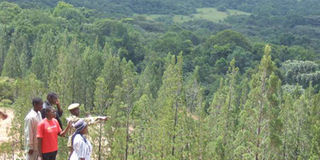UNDP in fresh bid to fence Kakamega forest

An aerial view of Kakamega Forest.
The United Nations Development Programme (UNDP) has renewed the push to secure the Kakamega forest with a solar-powered electric fence.
The fence will run 117km.
The plan aims to conserve the forest’s biodiversity, which has been under threat from illegal activities that include indiscriminate felling of indigenous trees by loggers and charcoal makers.
The forest is under intense pressure from local communities who depend on its resources for their livelihoods, including firewood and grazing their livestock.
The activities have eroded its biodiversity, setting off alarm bells from environmentalists.
The Kakamega forest is Kenya’s only surviving tropical rain forest, a vestige of the Guineo-Congolian rainforest that straddled the continent many years ago.
The fencing plans were developed following consultations in 2014 between the Kakamega County government and Rhino Ark, a charitable trust.
The project seeks to establish a partnership to promote the conservation of biodiversity and ecotourism and build the capacity of the local community to take part in the conservation campaign.
The initial plan to erect an electric fence was disrupted by the outbreak of the Covid-19 pandemic.
The project was to cost Sh500 million, with Rhino Ark contributing Sh156 million and the Kakamega and Vihiga county governments Sh100 million each.
Other key stakeholders in the campaign include the Kenya Forest Service (KFS), Kenya Wildlife Service (KWS) and community leaders.
An environmental and social impact study gave the project a clean bill.
The report said: “The project has more positive biophysical assessment impacts than negative ones. The forest is already surrounded by human activities with minimal natural habitat ecosystem connectivity hence insularisation of species is almost negligible.”
It added: “There will be increased forest regeneration with less livestock and higher success of growth for planted trees. Better forest health will enhance species diversity and abundance. Minimal net loss of biodiversity in the short term but far higher biodiversity net gain in the long term after project implementation.”
The UNDP team, led by Geoffrey Omedo, met Kakamega County Secretary James Ochami and announced they planned to provide funding under the Forestry and Lands Restoration Actions programme (FLRAP).
Similar programme elswhere
A similar programme is being implemented in three other counties – Kajiado, Narok, Elgeyo Marakwet. It focuses on conserving the environment and mitigating climate change.
Mr Omedo said the UNDP has stepped in to fund the project that will protect the forest and restore the regeneration of the biodiversity.
“The programme will entail the strengthening of the county’s capacity to conserve the forest and sensitise the community on the importance of protecting the water catchment,” said Mr Omedo.
Mr Ochami said: “We need to learn from the false start by the county and other stakeholders who were part of the project to fence the forest. We need to correct the mistake we made and ensure the project is implemented successfully.”
Environment, Natural Resources and Climate Change Chief Officer Mr Eugene Milimo said the enactment of the Environment Management Act provided a framework for engagements with partners and made it easy to work with other partners including the UNDP.
Kakamega Governor Wycliffe Oparanya, when he met a team from the Tourism Fund last year, protested the delay in implementing the project and accused officials from the national government of frustrating the plan.
Mr Alfonse Kioko, the chairman of the board of trustees of the Tourism Fund, promised to intervene to ensure the project was implemented.





